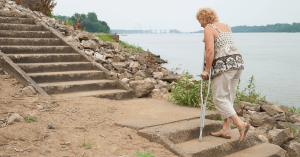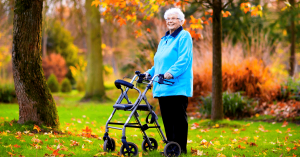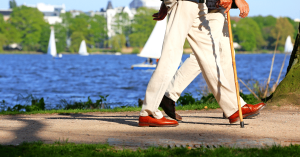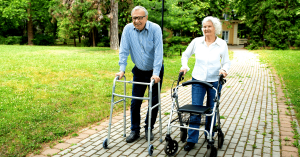
Wondering how to use a cane? There’s a right way and a wrong way of using a cane – I’ve seen it all! Make sure you’re using your cane the right way to reduce your risk of falls [1] and unnecessary aches and pains.
Table of Contents
Toggle1. Why use a cane?
Are you thinking that you might need to start using a cane but aren’t sure? If any of the below apply to you a cane may be of benefit:
- You have started having falls or near misses or are worried that you might
- You have noticed you have started to hold onto the furniture or walls when you are moving about your home
- You’ve got aches and pains in your legs that are making walking around harder work
- You have recently had an injury or surgery and are allowed to put weight through your legs but you just feel like you need a little extra support [2]
If any of the above sounds familiar it’s best to get your mobility assessed by a healthcare professional first. They will be able to check you over thoroughly and advise you on what might be helpful for you.
This is better and safer than using someone else’s old cane and trying to get by.
For your safety: If you’ve had an accident or injury and have been told you are not allowed to put full weight through your leg, you shouldn’t be using a cane. Only crutches or a walker are designed to help bear your weight and protect your injured leg [3].
2. Types of canes
There are many types of cane available with different handles, bottoms and looks. Some are foldable and some even come with a seat!
But more importantly your cane needs to be sturdy, hard wearing and adjustable to your height.
Single point canes are the most common type of cane, with one point of contact on the ground. See below:

The alternative is a quad cane which has four points on the ground. This can be useful for helping with balancing if you are unsteady on your feet. and need more support [4].
But it is also heavier and so harder to lift and carry about. See below:

3. How to measure/adjust your cane
Having your cane adjusted to the right height matters – if it’s too tall your shoulder will be up too high and you won’t get the support you need. If your cane is too short, you will probably be standing bent over with poor posture.
So here’s how to measure it correctly:
- Stand in a naturally upright position with your arm down by your side
- The handle of your cane should be roughly level with your wrist when your arm is resting down by your side
- When you have your hand on the handle of your cane, you should have a slight bend in your elbow and your shoulder should be relaxed down away from your ear
- If you have a height adjustable cane, push the small button in on the cane shaft. Then slide the shaft up or down to the correct height and then release the button into the right hole.
4. How to use a cane for walking
There is a certain way of using a cane correctly to help you walk.
You should hold your cane in the opposite hand to your injured or painful leg when walking. This is so that the cane can help support that leg properly.
If you don’t have an injury or pain but have one leg weaker than the other, the cane should still be held in the opposite hand to the weak leg.
If you are using a cane because you generally feel a bit wobbly or for confidence you can hold your cane in whichever hand you prefer.
When walking you should:
- Step forward with your painful or weaker leg first
- At the same time, move the cane forward on your opposite side.
- Then step forward with your other leg.
This ensures that your cane is supporting the leg that needs it most.
See the video below for an example of how to use a cane for walking:
5. How to use a cane on the stairs
Again, there is a certain way of getting up and down the stairs safely using a cane. If there is a rail or bannister available to hold onto please use it as a rail is going to be more secure than just holding the cane.
If there is a rail but it is on the side that you usually hold your cane on you can either:
- Swap your cane to the other hand and use both the rail and the cane
- Or just hold your cane without using it and just use the rail
Going up stairs:
- Step up onto the first step with your good leg
- Then step up onto the same step with your bad leg
- Then bring your cane up onto the same step as your legs
The reason for this order is that it is normally easiest to step up with your stronger leg first. The reason for bringing the cane up last is so that you can push down through it to help you up.
Top tip: Some people prefer to bring their cane up with their good leg instead as it feels more natural. This is ok as long as you’re not using your cane to push down heavily onto to help you step up.
Coming down stairs:
- Put your cane down on the first step
- Then step down onto the same step with your bad leg
- Then bring your good leg down onto the same step as your bad leg and cane
The reason we say put your cane down first on the way down is so that it is already there ready to support your bad leg before you even take a step down.
Top tip: When going up and down the stairs, think: ‘Good leg up first, bad leg down first’! Just don’t forget your cane first on the way down!
See the video below for how to use a cane on the stairs:
6. How to use a cane when standing up and sitting down
There are two safe techniques for standing up and sitting down with a cane, neither of which involve pushing down through your cane to stand up!
Standing up with a cane
Technique 1:
- Prop your cane somewhere close by where it won’t fall down so that you can easily reach for it once standing
- Push down with both arms on the chair to stand
- Once standing, reach for your cane before moving off away from the chair
Technique 2:
- Hold the end of your cane handle in the fingers of one hand, with the base of that same hand on the arm rest
- Push down with both hands on the chair to stand
- Now you are standing your cane is already in your hand ready to go!
For your safety: The reason not to just push down through your cane to stand up is because you can hurt your shoulder doing so, plus it’s not as safe or as steady as pushing up from the chair.
Sitting down with a cane
Get as close to the chair as you can before slowly stepping around using your cane until the chair is behind you. Then:
Technique 1:
- Prop your cane somewhere close by where it won’t fall down so that you can easily reach for it once standing
- Place both hands down on the chair
- Lower yourself down to sitting, slowly and with control – don’t throw yourself down!
Technique 2:
- Hold the end of your cane handle in the fingers of one hand
- Reach behind you with that same hand to rest the base of that hand on the arm rest
- Also place your other hand down on the other arm rest of the chair
- Lower yourself down to sitting, slowly and with control – don’t throw yourself down!
- Place your cane somewhere safe where you can reach it for when you are up again
Please see the video below for an example of how to use a cane when sitting down:
7. Safety tips when using a cane
Here are my top safety tips when using a cane:
- Check the ferrule (rubber stopper) on your cane regularly to make sure it hasn’t worn away
- Avoid slippery and icy surfaces when out walking with your cane as the rubber stopper will not be able to grip the ground properly
- Watch out for uneven ground e.g. paving slabs when out and about – you don’t want to catch your cane on them!
- Take care to remove or tape down bits of carpet/rugs at home that might be loose or sticking up that you could catch your feet or cane on
- If you are getting sore fingers, wrist or forearm it may be that the cane handle isn’t the right size or shape for you – in which case it may be worth getting a walking aid assessment from a physiotherapist
- Wearing a backpack around the house or up and down the stairs when using your cane allows you to keep your hands free and safely on the cane
Ok, so there you have it – everything you need to know about how to use a cane the right way – safely and correctly!
I hope you found this useful – if so, please pass it on to someone else who might benefit.
What to do next?
If you’re not sure whether a cane is for you, have a go at my quiz below:
Which mobility aid is right for you? QUIZ
And check out the following article:
Types of mobility aids – what you need to know!
If you’re keen to know more about other types of mobility aids, you can also have a look at my other walking aid guides:
References
[1] Clare Luz, PhD, Tamara Bush, PhD, Xiaoxi Shen, MS (2017) ‘Do Canes or Walkers Make Any Difference? NonUse and Fall Injuries’, The Gerontologist, Volume 57, Issue 2, 1 April 2017, Pages 211–218
[2] Ajemian, S. Thon, D. Clare P. et al (2004) ‘Cane-assisted gait biomechanics and electromyography after total hip arthroplasty’ Archives of Physical Medicine and Rehabilitation, vol 85. issue 12, pp. 1966-1971
[3] Youdas JW, Kotajarvi BJ, Padgett DJ et al. (2005) ‘Partial weight-bearing gait using conventional assistive devices’. Archives of Physical Medicine and Rehabilitation. 86(3) pp.394-8.
[4] Lam R. (2007) ‘Practice tips: choosing the correct walking aid for patients’. Canadian Family Physician. 53(12) pp. 2115-6.









